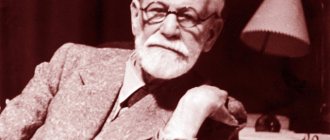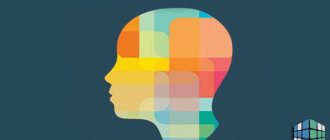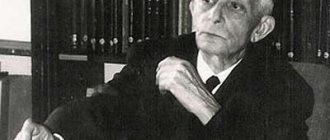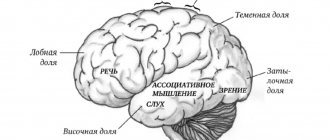It is impossible to talk about psychology today as a single science. Each direction in it offers its own understanding of mental reality, its functioning and approach to the analysis of certain aspects. Cognitive psychology is relatively young, but quite popular and progressive. We will briefly get acquainted with this scientific branch, its history, methods, basic provisions and features in this article.
Story
Cognitive psychology began with a meeting of young electronic engineering specialists at the University of Massachusetts on November 11, 1956. Among them were today's famous psychologists Newell Allen, George Miller and Noam Chomsky. They were the first to raise the question of the influence of human subjective cognitive processes on objective reality.
The book “The Study of Cognitive Development” by J. Bruner, published in 1966, became important for the understanding and development of the discipline. 11 co-authors, specialists from the Harvard Research Center, worked on its creation. However, the main theoretical work of cognitive psychology is recognized as the book of the same name by Ulric Neisser, an American psychologist and teacher at Cornell University.
Basic provisions
The main provisions of cognitive psychology can briefly be called a protest against the views of behaviorism (behavioral psychology, early 20th century). The new discipline stated that human behavior is a derivative of human mental abilities. “Cognitiveness” means “cognition”, “knowledge”. It is his processes (thinking, memory, imagination) that stand above external conditions. They form certain conceptual schemes with the help of which a person acts.
The main task of cognitive psychology can be briefly formulated as understanding the process of deciphering signals from the external world and interpreting them and making comparisons. That is, a person is perceived as a kind of computer that reacts to light, sound, temperature and other stimuli, analyzes all this and creates action patterns to solve problems.
General idea of thinking
Thinking
- this is the highest form of human cognitive activity, a socially conditioned mental process of indirect and generalized reflection of reality, the process of searching and discovering something essentially new.
The main features of the thinking process are:
1. Generalized and indirect reflection of reality.
2. Connection with practical activities.
3. Inextricable connection with speech.
4. The presence of a problematic situation and the absence of a ready answer.
6 pages, 2724 words
Psychology of communication and methods of influencing people on each other. Mechanisms...
... (touch, hug); sincerity. Imitation is the reproduction by a person of certain patterns of behavior, manner of speaking, way of thinking of another person. This is following general examples, standards, stereotypes, one thing... democratic, liberal. It is necessary to understand what influence is from a psychological point of view. Psychological influence - impact on the psychological state, thoughts, feelings, ...
Generalized reflection
in reality means that in the process of thinking we turn to that common thing that unites a similar number of objects and phenomena. For example, when we talk about furniture, we mean by this word tables, chairs, sofas, armchairs, cabinets, etc.
Indirect reflection
reality can be seen in the arithmetic problem of adding several apples or in determining the speed of two trains moving towards each other. “Apples” and “trains” are just symbols, conventional images, which should not be followed by specific fruits or compounds.
Thinking arises on the basis of practical activity
, from sensory knowledge, but goes far beyond its limits. In turn, the correctness of thinking is tested during practice.
Thinking is inextricably linked with speech
. Thinking operates with concepts, which in their form are words, but, in essence, are the result of mental operations. In turn, as a result of thinking, verbal concepts can be clarified.
Thinking takes place only when there is a problem situation
. If you can get by with the old ways of acting, then thinking is not required.
Peculiarities
Incompetent people often equate behaviorism and cognitive orientation. However, as mentioned above, these are separate, independent disciplines. The first is focused only on observing human behavior and the external factors (stimulus, manipulation) that shape it. Today, some of its scientific provisions are recognized as erroneous. Cognitive psychology can be briefly and clearly defined as a science that studies the mental (internal) states of a person. It is distinguished from psychoanalysis by scientific methods (rather than subjective sensations) on which all research is based.
The range of topics covered by the cognitive direction includes perception, language, memory, attention, intelligence and problem solving. Therefore, this discipline often overlaps with linguistics, behavioral neuroscience, issues of artificial intelligence, etc.
Beliefs (attitudes)
Beliefs are a deeper and more stable cognitive phenomenon.
Starting from childhood, people strive to understand the world around them. In order to adapt and organize their experience into a certain system, they look for logical relationships in what is happening to them. Interaction with the world and other people leads to the formation and assimilation of certain conclusions.
This is how people form certain beliefs about themselves, the people around them and the world as a whole. The most important, or deepest beliefs are attitudes that are so deep and fundamental that people often cannot clearly express them, or even simply realize them. The bearer of such ideas regards them as pure truth simply because that is how it “is.” This belief may only affect that person when they are depressed or active most of the time. When this deep view is activated, a person interprets everything that happens to him through the prism of this belief, despite the fact that, from the standpoint of common sense, the corresponding explanations may be frankly erroneous. In this case, a person may tend to take into account only information that confirms his core belief, ignoring or undervaluing information that contradicts it. This is how he maintains his core belief, even if it is wrong and dysfunctional.
Deep (basic) beliefs
Deep (basic) beliefs are a person’s key ideas about himself (self-concept), this is the fundamental level of beliefs; they are pervasive, ingrained and difficult to change, and overgeneralized.
All core beliefs can be divided into three categories: helplessness (for example, “I cannot exercise control”), rejection (for example, “I have a flaw, therefore I am unwanted”) and incompetence (for example, “I am inferior”). Some core beliefs fall into more than one category at once.
Deep beliefs in the category of helplessness include both beliefs in personal helplessness (powerlessness, vulnerability, limited means, inability to control the situation, weakness, neediness) and inadequacy of others in the sphere of achievements (failure, failure, inferior, incapable, good for nothing, Jonah). For example:
I'm unsuccessful. I'm not capable of anything. I'm helpless. I am a loser. I'm vulnerable. I need help and support. There is something wrong with me: I am not like others.
With typical core beliefs of rejection, a person believes that he has shortcomings that prevent him from receiving love and care from others. For example:
I am unworthy. I am unwanted. They don't like me. I'm not attractive. They don't care about me. I'm not good enough to be loved by others. I am destined to be abandoned, to suffer from loneliness.
Intermediate Beliefs
Intermediate beliefs occupy the space between core beliefs and automatic thoughts. They are formed on the basis of deep-seated beliefs. They, just like the deep ones, often cannot be clearly expressed in words. These include attitudes, inhibitions, rules/expectations, and assumptions.
Example of an attitude: “It’s terrible to be unloved!”
Example of a rule/expectation: “I should try to please others.” Rules can be rigid or flexible, for example: “I must always do the job perfectly” and “It is important to get the job done even if the result is not perfect.” Rules often focus on danger/safety and pain/pleasure. Rules are often referred to as “shoulds.”
An example of an assumption or conditional belief: “If I try hard to look good, I can keep a man by my side.”
An example of a prohibition: “Boys don’t cry.”
These beliefs influence a person's perception of a situation, which in turn determines the way he thinks, and then his emotions and behavior.
It is possible for a person to give up dysfunctional beliefs and acquire new ones that are functional and realistic. This goal can be achieved through the process of cognitive therapy.
In most cases, the therapist's initial attention is directed to the client's automatic thoughts, which are closest to the conscious level. To improve the client's well-being and encouragement, the therapist teaches the client to identify, evaluate, and change problematic thoughts. Only then does the therapist address the beliefs that support the dysfunctional ideas. Significant intermediate and core beliefs are subject to comprehensive analysis and then changed so that the client's perception of himself, other people and the world around him changes. These underlying changes reduce the likelihood of future recurrence of the disorder.
Automatic thoughts and beliefs are part of the cognitive model of emotional and behavioral disorders .
Methods
The main method of cognitivists is to replace the personal construct. Its development belongs to the American scientist J. Kelly and dates back to 1955, when the new direction had not yet been formed. However, the author’s work has largely become decisive for cognitive psychology.
Briefly, the personality construct is a comparative analysis of how different people perceive and interpret external information. It includes three stages. At first, the patient is given certain tools (for example, a thought diary). They help identify erroneous judgments and understand the causes of these distortions. Most often, they are states of passion. The second stage is called empirical. Here the patient, together with the psychotherapist, practices techniques for the correct correlation of phenomena of objective reality. This is done by formulating adequate arguments for and against, a system of advantages and disadvantages of behavioral models, and conducting experiments. The final step is for the patient to become more aware of his or her response. This is a pragmatic stage.
In short, Kelly’s cognitive psychology (or personality theory) is a description of the very conceptual scheme that allows a person to comprehend reality and form certain patterns of behavior. It was successfully picked up and developed by Albert Bandura. The scientist identified the principles of “observational learning” in behavior modification. Today, the personality construct is actively used by specialists around the world to study depressive states, phobias of patients and identify/correct the causes of their low self-esteem. In general, the choice of cognitive method depends on the type of mental behavioral disorder. These could be methods of decentering (for social phobia), replacing emotions, changing roles, or targeted repetition.
Forms of thinking
The main forms of thinking are concepts, judgments and inferences.
Concept
- a thought that reflects the general, essential characteristics of objects and phenomena.
For example, the concept of “person” includes such essential features as labor activity, upright walking, articulate speech, etc. The difference between a concept and an idea is that an idea is always an image, and a concept is a thought expressed in a word. In addition, a representation includes both essential and non-essential features, while a concept includes only essential ones. The content of concepts is revealed in judgments.
Judgment
– is a reflection of the connections between objects and phenomena or between their properties and characteristics.
From two or more judgments, you can build the next most complex form of thinking - inference.
Inference
- such a connection between concepts or judgments, as a result of which from one or more judgments we obtain a new judgment
Connection to neuroscience
Neuroscience is the study of behavioral processes in a broader sense. Today this science is developing in parallel and actively interacts with cognitive psychology. Briefly it touches on the mental level, and places greater emphasis on physiological processes in the human nervous system. Some scientists even predict that in the future the cognitive field may be reduced to neurobiology. The only obstacle to this will be theoretical differences between disciplines. Cognitive processes in psychology, in short, are more abstract and irrelevant to the views of neuroscientists.
An Experiment in Cognitive Dissonance
Cognitive dissonance occurs when a person is forced to do something that deep down he does not want to do. In this case, dissonance is created between the cognition “I don’t want to do this” and actual behavior. A person's actions that are clearly inconsistent with his beliefs are called forced compliance.
Since no one can change their past actions, the only way to reduce dissonance is to change the attitude towards their actions. To clearly demonstrate the phenomenon of forced compliance, Leon Festinger and James Carlsmith conducted the following experiment.
Problems and discoveries
W. Neisser's work “Cognition and Reality,” published in 1976, identified the main problems in the development of the new discipline. The scientist suggested that this science cannot solve everyday problems of people, relying only on laboratory experimental methods. He also gave a positive assessment of the theory of direct perception developed by James and Eleanor Gibson, which can be successfully used in cognitive psychology.
American neurophysiologist Karl Pribram briefly touched on cognitive processes in his developments. His scientific contribution is related to the study of “brain languages” and the creation of a holographic model of mental functioning. During the last work, an experiment was carried out - resection of the brains of animals. After large areas were removed, memory and skills were preserved. This gave grounds to assert that the entire brain, and not its individual areas, is responsible for cognitive processes. The hologram itself worked based on the interference of two electromagnetic waves. When any part of it was separated, the entire image was preserved, although less clearly. Pribram's model has not yet been accepted by the scientific community, however, it is often discussed in transpersonal psychology.
Mental operations
The thinking process includes several operations: comparison, analysis, synthesis, abstraction, generalization, specification.
Analysis
- mental division of an object into its constituent elements with their subsequent comparison. For example, a psychologist analyzes the personal qualities of his client based on the results of the Cattell test.
Synthesis
- combining individual components into a whole. Usually adjacent to analysis. Continuing the previous example, let us imagine how a psychologist, after analyzing several tests, builds a generalized psychological portrait of a person.
Abstraction
- highlighting one side of an object or phenomenon that in reality does not exist as a separate side. As a result of abstraction, concepts are formed. As an example, we can take the concept of “reliability”, as a low probability of breakdown of some type of household appliance.
Generalization
— highlighting common essential properties in compared objects. For example, after analyzing sales of individual types of bread, the owner of a bakery comes to the conclusion that butter buns are in best demand, regardless of their size and fillings.
Specification
- an operation inverse to generalization, the identification of characteristics of an object or phenomenon that are characteristic of it, not related to the features common to the class of the object or phenomenon. For example, the owner of a mini-bakery, having discovered the increased demand for buns, decides to bake them a new type - with sesame seeds and strawberry filling.
Examples of similar educational works
Human psychology
... a person, upon awakening, is filled with simple ideas, begins to think, that is, to form complex ideas. Locke introduced into the language of psychology the concept of... mental processes (from perception to thinking inclusive) as the orienting activity of the subject in...
Human Psychology 4
... thinking. For example, monkeys are characterized by mental activity that is more complex than that of other animals. This stage of the psyche is called the stage of intelligence. Combining all of the listed stages of a person’s psyche…to everyone—everything carries information about everything. This …
HUMAN PSYCHOLOGY 5
... were guided by the fact that classes in the course “Human Psychology” should contribute to the conscious assimilation of the theoretical foundations of modern ... lesson No. 14 Topic “attention” Plan: The concept of attention. Basic types of attention. Characteristics of properties...
Human Psychology in Islam
...not to mention the basic tenets of faith. So, let's look at human psychology in Islam. 1. Being with Allah. And when... a real Muslim. Prayer in Islam is inextricably linked with such a concept as tawhid, that is, consubstantial with Allah. She reflects...
Post-non-classical human psychology
... the creation of a special discipline - psychological anthropology, which studies human psychology in its specifics [4: p. 32-33]. ... co-existential community. The fundamental status of the concept of “co-existential community of people” as a special space where ...











